中国书法英语
关于中国书法的优秀英语作文范例
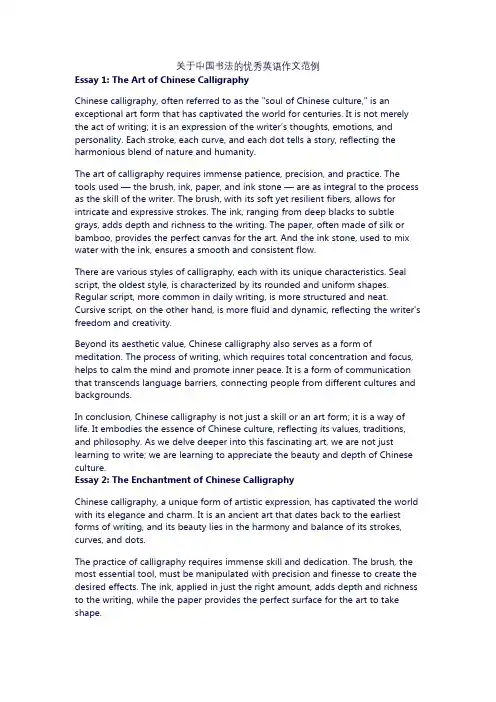
关于中国书法的优秀英语作文范例Essay 1: The Art of Chinese CalligraphyChinese calligraphy, often referred to as the "soul of Chinese culture," is an exceptional art form that has captivated the world for centuries. It is not merely the act of writing; it is an expression of the writer's thoughts, emotions, and personality. Each stroke, each curve, and each dot tells a story, reflecting the harmonious blend of nature and humanity.The art of calligraphy requires immense patience, precision, and practice. The tools used — the brush, ink, paper, and ink stone — are as integral to the process as the skill of the writer. The brush, with its soft yet resilient fibers, allows for intricate and expressive strokes. The ink, ranging from deep blacks to subtle grays, adds depth and richness to the writing. The paper, often made of silk or bamboo, provides the perfect canvas for the art. And the ink stone, used to mix water with the ink, ensures a smooth and consistent flow.There are various styles of calligraphy, each with its unique characteristics. Seal script, the oldest style, is characterized by its rounded and uniform shapes. Regular script, more common in daily writing, is more structured and neat. Cursive script, on the other hand, is more fluid and dynamic, reflecting the writer's freedom and creativity.Beyond its aesthetic value, Chinese calligraphy also serves as a form of meditation. The process of writing, which requires total concentration and focus, helps to calm the mind and promote inner peace. It is a form of communication that transcends language barriers, connecting people from different cultures and backgrounds.In conclusion, Chinese calligraphy is not just a skill or an art form; it is a way of life. It embodies the essence of Chinese culture, reflecting its values, traditions, and philosophy. As we delve deeper into this fascinating art, we are not just learning to write; we are learning to appreciate the beauty and depth of Chinese culture.Essay 2: The Enchantment of Chinese CalligraphyChinese calligraphy, a unique form of artistic expression, has captivated the world with its elegance and charm. It is an ancient art that dates back to the earliest forms of writing, and its beauty lies in the harmony and balance of its strokes, curves, and dots.The practice of calligraphy requires immense skill and dedication. The brush, the most essential tool, must be manipulated with precision and finesse to create the desired effects. The ink, applied in just the right amount, adds depth and richness to the writing, while the paper provides the perfect surface for the art to take shape.The various styles of calligraphy each have their own unique characteristics and aesthetic values. Seal script, the oldest style, is known for its rounded and uniform shapes, while regular script is more structured and neat. Cursive script, on the other hand, is more free-flowing and expressive, reflecting the writer's emotions and creativity.Beyond its aesthetic appeal, Chinese calligraphy also serves as a form of relaxation and meditation. The act of writing, which requires total concentration and focus, helps to calm the mind and promote inner peace. It is a form of self-expression that allows individuals to connect with their inner selves and express their thoughts and feelings.In conclusion, Chinese calligraphy is an enchanting art form that captivates the senses and ignites the imagination. Its beauty lies not only in its aesthetic value but also in its ability to connect with the inner world of the writer. As we delve deeper into the world of calligraphy, we discover a world of beauty, creativity, and tranquility that transcends the boundaries of language and culture.Essay 3: The Timeless Beauty of Chinese CalligraphyChinese calligraphy, often described as the "dance of the brush," is a timeless art form that has withstood the test of centuries. It is not just about writing characters; it's an expression of the artist's soul, emotions, and thoughts. Each stroke, each curve, and each dot tells a unique story, reflecting the harmony and balance of the universe.The allure of calligraphy lies in its ability to captivate and transport the viewer to a different world. The brush, manipulated with precision and finesse, creates a dance of ink on paper, much like a painter's brush strokes on canvas. The ink, ranging from deep blacks to subtle grays, flows gracefully, creating a visual masterpiece that is both calming and inspiring.The practice of calligraphy requires immense patience and dedication. It is not a skill that can be mastered overnight; it takes years of practice and refinement. The artist must have a deep understanding of the characters they are writing, their history, and their cultural significance. This knowledge adds depth and meaning to the art, making it more than just a visual treat.Moreover, Chinese calligraphy is a form of meditation. The act of writing, which requires total concentration and focus, helps to clear the mind and promote inner peace. It is a form of therapy that allows individuals to express their thoughts and feelings through the medium of the brush and ink.In conclusion, the timeless beauty of Chinese calligraphy continues to captivate and inspire people across the globe. Its elegance, grace, and depth make it a unique art form that deserves recognition and appreciation. As we delve deeper into the world of calligraphy, we discover a world of beauty, creativity, and tranquility that is both timeless and eternal.Essay 4: The Spiritual Dimension of Chinese CalligraphyChinese calligraphy, often referred to as the "soul of Chinese culture," is an art form that transcends the boundaries of mere writing. It is a spiritual journey that allows the writer to connect with their inner selves and express their thoughts and emotions in a unique and profound way.The practice of calligraphy requires immense concentration and focus. The writer must be in a state of complete tranquility, with their mind free from distractions. This state of mind allows them to connect with the universal energy and channel it through their brush, creating beautiful and harmonious strokes.The brush, ink, paper, and ink stone are not just tools; they are extensions of the writer's soul. The brush, with its soft yet resilient fibers, allows for intricate and expressive strokes. The ink, ranging from deep blacks to subtle grays, adds depth and richness to the writing. The paper, often made of silk or bamboo, provides the perfect canvas for the art. And the ink stone, used to mix water with the ink, ensures a smooth and consistent flow.The various styles of calligraphy, each with their unique characteristics, reflect the writer's personality, emotions, and spiritual beliefs. Seal script, the oldest style, is characterized by its rounded and uniform shapes, reflecting a sense of stability and balance. Regular script is more structured and neat, reflecting a sense of order and discipline. Cursive script, on the other hand, is more free-flowing and dynamic, reflecting the writer's freedom and creativity.In conclusion, Chinese calligraphy is not just an art form; it is a spiritual practice that allows individuals to connect with their inner selves and express their thoughts and emotions in a unique and profound way. It is a form of meditation that helps to calm the mind and promote inner peace. As we delve deeper into the world of calligraphy, we discover a world of beauty, creativity, and spirituality that is both enchanting and transformative.Essay 5: Chinese Calligraphy: A Bridge to Cultural UnderstandingChinese calligraphy, often regarded as the essence of Chinese culture, serves as a powerful bridge between different cultures and backgrounds. Through the strokes, curves, and dots of the brush, it tells the story of China's rich history, traditions, and values.The art of calligraphy is not just about writing; it's about communicating thoughts and emotions in a unique and profound way. Each stroke, each curve, and each dot carries deep cultural significance, reflecting the harmony and balance of Chinese philosophy.The practice of calligraphy requires immense patience, precision, and dedication. It is a form of meditation that helps to calm the mind and promote inner peace. As the brush glides smoothly over the paper, the writer's thoughts and emotions flow freely, creating a beautiful and harmonious masterpiece.The various styles of calligraphy, each with their unique aesthetic value, reflect the diversity and complexity of Chinese culture. Seal。
中国书法简介英语版chinesecalligraphy完整版
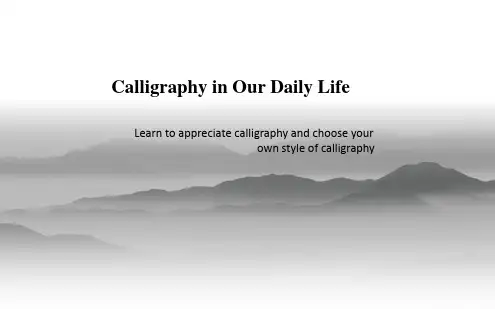
Maybe you have ever heard these names: Tian Yingzhang(田英章) Lu Zhongnan(卢中南) Sima Yan(司马彦)——He is really interesting. Last century, his style is very popular, but his style is similar to Tian Yingzhang now.
2.Recent calligrapher
Ancient times has gone, there are also many creative calligrapher
Qi Gong(启功)
Liu Bingseng(பைடு நூலகம்炳森)
Zhao Puchu(赵朴初)
Professor of Beijing Normal University
Funeral Oration for My Nephew(祭侄文稿)
Cold food observance (黄州寒食帖)
The Orchid Pavilion
Funeral Oration for My Nephew
Cold food observance(黄州寒食帖)
This is a representative masterpiece of Su Shi, it is created to express his depression. In the third year in Huangzhou, he spent Cold food observance alone, and wrote it with mixed feeling
用英语介绍中国文化书法
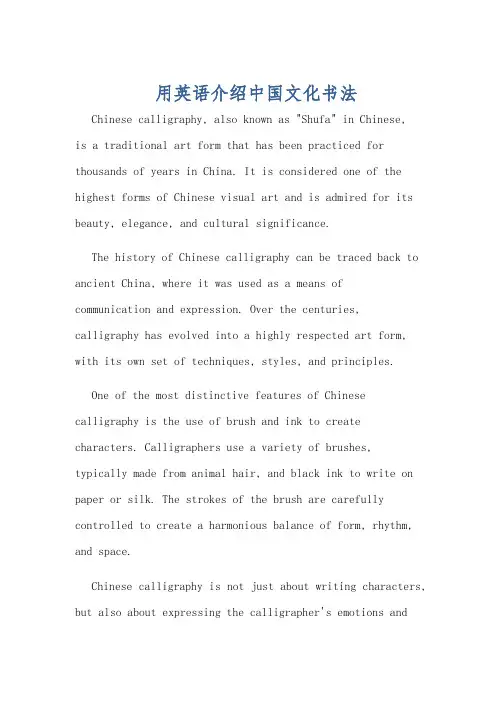
用英语介绍中国文化书法Chinese calligraphy, also known as "Shufa" in Chinese,is a traditional art form that has been practiced for thousands of years in China. It is considered one of the highest forms of Chinese visual art and is admired for its beauty, elegance, and cultural significance.The history of Chinese calligraphy can be traced back to ancient China, where it was used as a means of communication and expression. Over the centuries,calligraphy has evolved into a highly respected art form, with its own set of techniques, styles, and principles.One of the most distinctive features of Chinese calligraphy is the use of brush and ink to create characters. Calligraphers use a variety of brushes,typically made from animal hair, and black ink to write on paper or silk. The strokes of the brush are carefully controlled to create a harmonious balance of form, rhythm, and space.Chinese calligraphy is not just about writing characters, but also about expressing the calligrapher's emotions andpersonality. Each stroke is infused with the calligrapher's energy and spirit, making each piece of calligraphy aunique work of art.There are several major styles of Chinese calligraphy, each with its own unique characteristics and history. These styles include Seal Script, Clerical Script, Regular Script, Running Script, and Cursive Script. Each style has its own rules and conventions, and calligraphers often spend years mastering a particular style.In addition to its artistic value, Chinese calligraphy also holds significant cultural and philosophical meanings. It is often associated with concepts such as harmony, balance, and discipline, reflecting the core principles of traditional Chinese culture.Chinese calligraphy has also had a profound influence on other forms of art and culture, such as painting, poetry, and even martial arts. Many famous Chinese artists, scholars, and poets have also been skilled calligraphers, and their works have greatly enriched the cultural heritage of China.In modern times, Chinese calligraphy continues to thrive as a cherished art form, with many enthusiasts and practitioners around the world. It is often practiced as a form of meditation and mindfulness, offering a way to cultivate inner peace and self-expression.Overall, Chinese calligraphy is a rich and profound art form that embodies the essence of Chinese culture. It is a testament to the creativity, wisdom, and spiritual depth of the Chinese people, and it continues to inspire andinfluence artists and admirers around the world.中国书法,又称“书法”,是中国传统艺术形式之一,已有数千年的历史。
英语演讲-中国书法
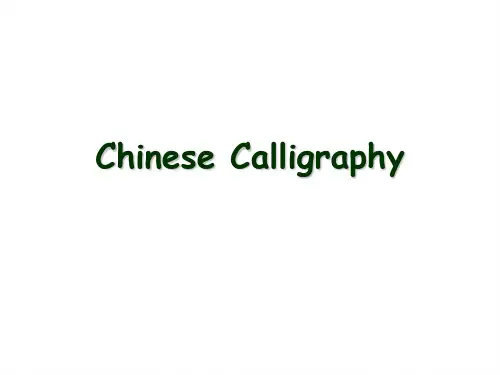
Sui and Tang Dynasties Great calligraphers:
※Zhang
hand
※Yan ※Liu ※the
Xu master of the cursive
Zhenqing Gongquan monk Huai Su
Song and Yuan Dynasties
the four great masters of Song: ※Su Shi
书)
Eastern Han Xingshu(行
书)
from the Three Kingdoms through the Western and Eastern Jin dynasties to the Southern and Northern 楷书) kaishu(楷书)
Eastern Jin Dynasty Wang XiZhi Was respected as the “master of calligraphy”.
※
The Developement of Chinese Calligraphy
Shang Dynasty
文) 字)
Jiaguwen(甲骨
Pictograph(象形文
Qin Dynasty 小篆) Xiaozhuan(小篆)
Han Dynasty Lishu(隶
书)
Eastern Han Caoshu(草
Chinese Calligraphy
The Defination of Chinese Calligraphy
※Calligraphy
is a kind of Chinese traditional arts, which expresses personal affection through four treasures in the study, writing brush, ink stick, ink slab, and paper.
中国书法英语作文:ChineseCalligraphy
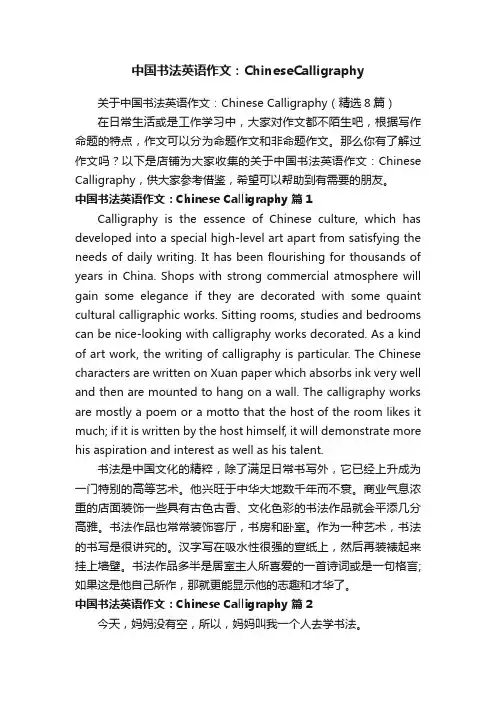
中国书法英语作文:ChineseCalligraphy关于中国书法英语作文:Chinese Calligraphy(精选8篇)在日常生活或是工作学习中,大家对作文都不陌生吧,根据写作命题的特点,作文可以分为命题作文和非命题作文。
那么你有了解过作文吗?以下是店铺为大家收集的关于中国书法英语作文:Chinese Calligraphy,供大家参考借鉴,希望可以帮助到有需要的朋友。
中国书法英语作文:Chinese Calligraphy 篇1Calligraphy is the essence of Chinese culture, which has developed into a special high-level art apart from satisfying the needs of daily writing. It has been flourishing for thousands of years in China. Shops with strong commercial atmosphere will gain some elegance if they are decorated with some quaint cultural calligraphic works. Sitting rooms, studies and bedrooms can be nice-looking with calligraphy works decorated. As a kind of art work, the writing of calligraphy is particular. The Chinese characters are written on Xuan paper which absorbs ink very well and then are mounted to hang on a wall. The calligraphy works are mostly a poem or a motto that the host of the room likes it much; if it is written by the host himself, it will demonstrate more his aspiration and interest as well as his talent.书法是中国文化的精粹,除了满足日常书写外,它已经上升成为一门特别的高等艺术。
Introduction_to_Chinese_Calligraphy 中国书法英语介绍
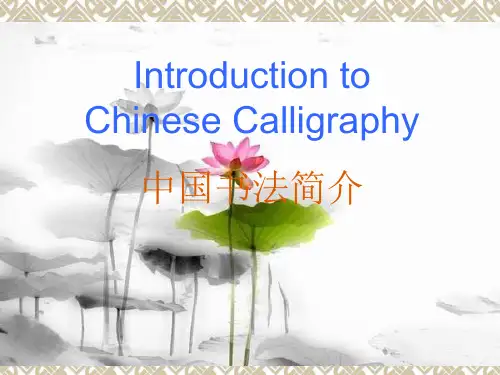
Calligraphy of Wang Xianzhi
Wang Xizhi has 7 sons and a daughter .All of them were good at calligraphy ,but Wang Xizhi was more extraordinary. He was talented and created in calligraphy ,and greatly contributed to the continuous development of Chinese calligraphy.
Introduction to Chinese Calligraphy
中国书法简介
Introduction to Chinese Calligraphy
The
development of calligraphy Calligraphy font Writing tools The importance of calligraphy
paper纸 Inkstone砚
Writing tools
பைடு நூலகம்
The importance of calligraphy
●Use
as an important criterion for selection of executives to the Imperial court. ●Developing an international art.
中国书法简介英语版-chinese calligraphy(完整版)
content
1.Ancient calligraphy works 2.Recent calligraphers 3. Hard-tipped pen calligraphy(硬笔书法) 4.Questions and answers
1.Ancient calligraphy works
Have you ever noticed these shop signs? Do you know the origin of these fonts?
Hard-tipped pen calligraphy is a new style of calligraphy derived from traditional calligraphy. It is really useful nowadays. Also there are many famous calligraphers.
li calligraphy(隶书),such as caoquan(曹全碑)
Song typeface,created by Qin Hui
华文行楷
方正舒体
华文新魏
1.1 Regular script(楷书) Four calligraphers are famous for their regular script, and the scripts are called ou yan liu zhao(欧颜柳赵),their names are as following: OuYang xun(欧阳询) Yan Zhenqing(颜真卿) Liu Gongquan(柳公权) Zhao Mengfu(赵孟頫)
Three calligraphers are famous for their running hand, and their best running hand are called three best running hand
了解中国书法的英语作文
了解中国书法的英语作文Chinese calligraphy, also known as "shufa" in Chinese, is a traditional art form that has a long history and profound cultural significance in China. It is not only a means of communication but also a unique art that embodies the beauty of Chinese characters. Chinese calligraphy has been widely practiced and admired for thousands of years and continues to be a popular form of artistic expression today.The origins of Chinese calligraphy can be traced back to ancient times when Chinese characters were first invented. The art form developed alongside the Chinese writing system, which has evolved over several dynasties. Calligraphers used various writing tools, such as brushes, ink, and paper, to create beautiful and aesthetically pleasing characters. They cultivated a profound understanding of brush strokes, inkdistribution, and the proper balance of space to create visually appealing and harmonious compositions.Chinese calligraphy is not merely a matter of writing characters; it is an art that requires both skill and creativity. Calligraphers must be well-versed in the rules of stroke order, proportions, and balance. Every stroke must be executed with precision and fluidity, showcasing the individual style and artistic expression of the calligrapher. Through years of practice and dedication, calligraphersstrive to achieve a harmonious and rhythmic balance between characters, lines, and spaces.One of the key aspects of Chinese calligraphy is "qi," which refers to the vital energy or life force that flows through the strokes. Calligraphers must cultivate a sense of tranquility and focus while creating their work, allowing the energy to flow naturally from their brush onto the paper. The expression of "qi" in calligraphy gives life and vitality tothe characters, creating a sense of dynamic movement and expression.Chinese calligraphy encompasses various styles, each with its own unique characteristics and historical significance. The most well-known styles include seal script, clerical script, regular script, running script, and cursive script. Each style has its own rules and techniques, offering a wide range of artistic expression for calligraphers to explore.In addition to its artistic value, Chinese calligraphyalso carries profound cultural and philosophical connotations. Calligraphers often draw inspiration from classical Chinese literature, philosophy, and spirituality, infusing their work with timeless wisdom and messages. Chinese calligraphy is considered a way to cultivate the mind and nurture the soul, and it is highly respected as a form of self-expression and self-discipline.Today, Chinese calligraphy continues to flourish both in China and around the world. It is practiced by people of all ages and backgrounds, from professional calligraphers to enthusiasts who simply enjoy the meditative process ofcreating beautiful characters. Chinese calligraphy has also gained recognition as an intangible cultural heritage by UNESCO, further cementing its significance and value on a global scale.In conclusion, Chinese calligraphy is a remarkable artform that embodies the beauty and cultural depth of China. It requires not only technical skill but also a deepappreciation for the artistic expression of Chinese characters. With its rich history, diverse styles, and profound cultural significance, Chinese calligraphy is an art form that continues to captivate and inspire people worldwide.。
中国书法英语作文
Chinese calligraphy is an ancient art form that has been cherished and developed in China for thousands of years.It is not only a means of writing but also a form of expression that combines aesthetics,philosophy,and emotion.Origin and HistoryCalligraphy in China dates back to the Neolithic period,with the earliest forms of writing appearing on oracle bones and bronze vessels.Over time,it evolved into various styles, including the four major script styles:Seal Script,Clerical Script,Regular Script,and Cursive Script.Each style has its unique characteristics and is associated with different periods and dynasties.Philosophical SignificanceChinese calligraphy is deeply rooted in Chinese philosophy,especially Taoism and Confucianism.It is believed that the art of calligraphy can reflect the inner spirit and moral character of the calligrapher.The strokes and structure of the characters are thought to mirror the balance and harmony of the universe.Techniques and ToolsThe essential tools for Chinese calligraphy are the Four Treasures of the Study:the brush, ink,paper,and inkstone.The brush is chosen for its flexibility and ability to hold ink.Ink is made from soot and animal glue,creating a rich black color when applied to special rice paper or silk.The inkstone is used to grind the ink into the desired consistency. Styles and FormsCalligraphers often practice different styles to express various moods and ideas.For instance,Regular Script is neat and balanced,suitable for official documents and inscriptions.Cursive Script,on the other hand,is fluid and dynamic,often used to convey a sense of urgency or passion.Cultural ImpactChinese calligraphy has had a profound influence on East Asian cultures,including Japan, Korea,and Vietnam,where similar art forms have developed.It is also appreciated worldwide for its aesthetic appeal and the meditative process involved in its creation.Learning and PracticeMastering Chinese calligraphy requires patience,discipline,and a deep understanding of the language.Beginners often start by copying the works of ancient masters to learn the structure and rhythm of the characters.Over time,they develop their own style and expressiveness.Modern AdaptationsIn the modern era,Chinese calligraphy continues to be a popular art form.It is used in various contexts,from traditional scroll painting to contemporary graphic design.Many artists also experiment with new materials and techniques,blending traditional calligraphy with modern art.ConclusionChinese calligraphy is more than an art it is a cultural treasure that embodies the essence of Chinese civilization.It continues to be a source of inspiration and a means of cultural exchange,offering a window into the rich history and philosophy of China.。
中国书法英语作文
中国书法英语作文中国书法英语作文1Easier - Calligraphy is the art of making beautiful or elegant handwriting.It is a fine art of skilled penmanship.Harder - The word calligraphy literally means beautiful writing.Before the invention of the printing press some 500 years ago, it was the way books were made.Each copy was handwritten out by a scribe working in a scriptorium.The hand writing was done with quill and ink onto materials like vellum or parchment.The lettering style applied was one of the period bookhands like rustic, carolingian, blackletter, etc.Today, there are three main types or styles of calligraphy: (1) Western or Roman, (2) Arabic, and (3) Chinese or Oriental.This project focuses mainly on Western calligraphy with a glimpse at the other two styles.中国书法英语作文2Calligraphy is the essence of Chinese culture, which has developed into a special high-level art apart from satisfying the needs of daily writing.It has been flourishing for thousands of years in China.Shops with strong commercial atmosphere will gain some elegance if they are decorated with some quaint cultural calligraphic works.Sitting rooms, studies and bedrooms can be nice-looking with calligraphy works decorated.As a kind of art work, the writing of calligraphy is particular.The Chinese characters are written on Xuan paper which absorbs ink very well and then are mounted to hang on a wall.The calligraphy works are mostly a poem or a motto that the host of the room likes it much; if it is written by the host himself, it will demonstrate more his aspiration and interest as well as his talent.书法是*文化的精粹,除了满足日常书写外,它已经上升成为一门特别的高等艺术。
